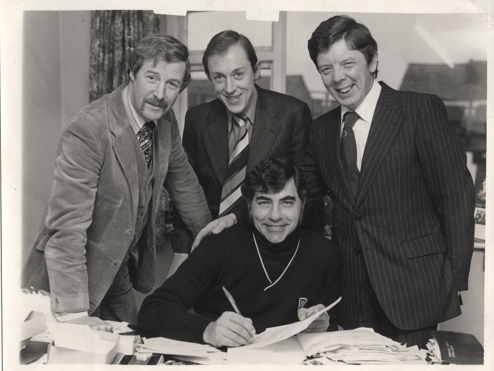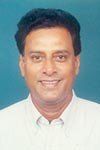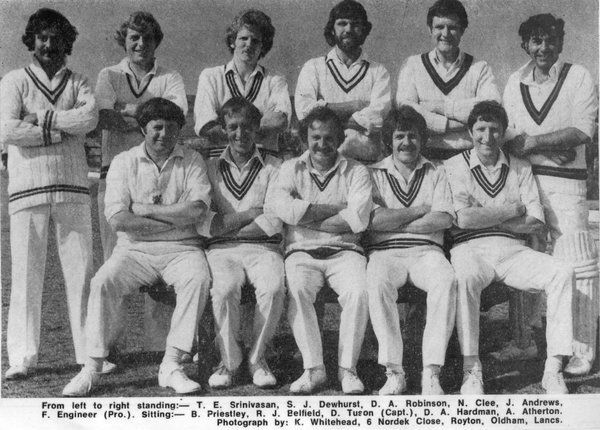After a disappointing season from the Club’s professional, Paul Tipton, in 1976 the Club decided to go for a proven and tested professional for the next season. Chairman of the Club’s professional sub-committee, Arthur Robinson, was determined to put Woodhouses on the map and he personally took the lead in going for a big name professional of proven ability and performance.
Upon hearing the County were no longer retaining the services of their wicket-keeper batsman Farokh Engineer, Arthur quickly made contact with Farokh and entered into personal negotiations for a contract with Woodhouses. The signing of the Indian and Lancashire CCC star by a small village cricket club aroused a good deal of media interest.
He was an instant success with members and players alike through his charm and personality particularly with the ladies of the club!
It was a little time before the Club was to see Farokh at the crease as the first two games of the season were called off due to rain. He eventually made his debut for the club on 1st May 1977 in the First Round of the Walkden Cup at Moorside. The crowd including many from Woodhouses must have considered it worth waiting for because the ex-Lancashire batsman scored a cultured 64 on a seamer’s paradise. He made an impressive start to the season and late in June he was re-signed for the following season. He went on to score, for his proven ability, a modest total of 775 runs at an average of 36.9.
At no stage did he ever find it difficult to score runs even on difficult seamers wickets because of his excellent footwork. His best knock of the season was again on a difficult wicket at Moorside when he scored a marvellous 131 not out from of a total of 234-6. There were times when he disappointed with the bat but that could never be said about his wicket-keeping. He made the art of wicket-keeping look very easy and he was able to stand up comfortably to all the 1st X1 bowlers.
Batsman had no margin for error on the leg side if they overstretched and lost their balance. His first stumping for the Club was a very wide ball down the leg side and just one bail was removed in double quick time. The players were impressed none more so than the bowler, Richard Belfield, who had given it up as a wide. Richard’s bowling enjoyed something of a renaissance whist Farokh was behind the stumps.
A major bonus of having Farokh on the team was to unfold though quite unexpectedly in the middle of May. The 1st X1 were away at Stalybridge when one T. E. Srinivasan arrived on the ground part way through our innings. Earlier in the day ‘T’, as he affectionately became known, had rung Farokh out of the blue to say he would like to come and play for Woodhouses. Farokh did not know him but suggested he came along to Stalybridge to discuss the possibility and meet the players. ‘T’ introduced himself to Farokh and at the tea interval he went out for a little knock on the outfield while Farokh bowled to him. Whist he looked reasonably competent in the knock up there was nothing special to catch the eye.
As chance would have it the following day a club practice match had been arranged to replace a friendly that had been cancelled at short notice. ‘T’ was invited to play and given the opportunity to open the innings. The teams were a mix of 1st X1 batters and 2nd team bowlers and vice versa. A young and athletic David Robinson at that time, opening bowler for the First X1 opened up with ‘T’ on strike. In the first over David rapped him on the pads low down, playing back and covering all 3 wickets. ‘Plumb Out’ under normal circumstances but the umpire (David’s Dad no less) sensibly declined to respond positively to David’s deafening and demonstrative appeal for L.B.W. in the wider interests of giving ‘T’ an opportunity to bat.. ‘T’ did not make another mistake until he was out with over a 100 to his name. The players witnessed what they would experience many other times during the season, an innings of sheer quality which had class and authority stamped all over it. He had made an indelible mark on the proceedings and the Club was buzzing with the prospects of their new and unexpected acquisition. All that remained to be done was to find ‘T’ some accommodation for the summer and a job to keep him occupied during the week. A number of members helped out with the accommodation (and his washing!) and a temporary clerical job was found for him by Dave Hardman in the Manchester Town Hall.
He made his debut in the League at home against Moorside and scored a quick fire 30 including 2 sixes. He continued to delight the club’s players and spectators until the middle of August when he had to return home early. In that time he played 18 innings for the club and scored a total of 812 runs at an average of 58.00 which won him the League batting prize. His most memorable innings was against Hyde at Woodhouses when he scored 121 out of a total of 198-9. It was an electrifying innings where he blazed away against some quality bowlers, it contained some 13 fours and 6 mighty sixes. An innings long remembered by those lucky enough to see it.
‘T’ returned to India before the end of the season so he could repay his employer, India Cements, who had sponsored his visit to England. The players were disappointed to see him go but he did say he hoped to be back the following season as he had enjoyed it so much. This was music to the ears of everyone in the club. He had learnt a lot about playing in English conditions and hopefully he would return an even better player.
At that time the League’s points system did not do the club any favours as it was 5 points for an outright win and 3 points if you did not bowl the other team out. Batting was the strong point of the 1st X1 not the bowling. Consequently opposing teams would put Woodhouses in first if they won the toss and then shut up shop and hold out for a point. The club finished runners up just 3 points behind the winners Denton St Lawrence. It is also worth mentioning that ‘T’ bowled a 31 overs of medium pace and took 7 wickets at an average of 16.28. He was actually a leg spinner but it had not been the warmest of summers and he did not bowl his leg spinners because as he put it “his fingers were too cold in the chilly conditions!”
What enduring cricket memories did ‘T’ leave at Woodhouses that summer? He had quickly demonstrated that he had sheer class and pedigree as a batsman. He could play shots all around the wicket and invariably they went like ‘rockets’. He was savage and brutal to anything short of a length. He was quick on his feet, very wristy with classical on side shots whipped away through mid-wicket to the boundary edge. He was refined and cultured against the length ball but if the mood took him, as it often did, he would dance down the wicket and treat the ball with almost contemptuous disdain in rocketing it to the boundary. No wonder his cult following at Woodhouses flocked to see his elegant mastery of the bowling and were thrilled at the prospect of him returning the following season. There had been many innings when ‘T’ completely overshadowed Farokh.
On 17th August that year the club hosted a benefit game for Farokh and he put together an invitation X1 to play against a select Woodhouses X1. Farokh’s team included many of his former playing colleagues at Lancashire CCC including Barry Wood, Frank Hayes Harry Pilling David Hughes Jack Simmons and Peter Lever.
In 1978 news reached the club in March that ‘T’ would be definitely be back. Farokh was looking forward to the new campaign and hoped to make a better impact with the bat. Farokh was not renowned for spending his money but he even pushed the boat out and surprised everyone by holding a pre-season party for all the players and their partners at his home in Sale. It was however a good job the players took plenty of drinks with them as there only seemed to be the odd bottle of sherry on offer! Everyone did however enjoy a good curry.
The team finished 4th in the League despite scoring even more runs than the season before. It experienced the same problem as the previous season with the inability of the bowlers to dismiss the opposition and record maximum points.
Farokh never got going and had for him a very disappointing season with the bat. He scored 655 runs at an average of 27.2 with a top score of 91. His heart did not seem to be really in it and his mind seemed to be more focussed on developing a media career as a cricket commentator. He actually missed a few games to do live coverage on Granada TV of the Roses matches that season. David Hughes from Lancashire was deputy professional in his absence. He scored 90 runs and took 6 wickets in 2 matches for the club. An amusing incident occurred is his first game for the club which is worthy of mention.
David as deputy pro was keen as mustard to do well and had given the team a lively pep talk in the dressing room about the importance of bowlers concentrating on line and length and the fielders being on their toes throughout the innings.
The players were ‘geed up’ and wanted to impress Mr. Hughes. David Robinson was to bowl the first over and David Hughes was in the covers. ‘Robbo’ or ‘Pieman’ as he was affectionately known to his team mates, steamed into the wicket and bowled one of his famous ‘Bless My Soul’ deliveries as Peter Rushworth used to call them! Somehow the ball came out of the back of David’s hand and looped in the direction of David Hughes at cover.
The ball rolled very slowly across the square and eventually nestled against the boot of David Hughes. He looked up with an expression on his face which seemed to convey “What sort of fish and chip shop league am I playing in today?”
Later in the 1978 season the club drew Timperley in a round of a Lancashire Cup Competition. John Andrew had joined the club from Werneth. He had a large frame and significant presence due to his size. He was a hard hitting opening batsman and was no slouch with the ball. During the season he formed a very strong opening partnership with Dave Hardman. In this match Woodhouses batted first and both opening batters were in good touch on a great batting track. They had both scored some 30+ runs when John played a ball to fine leg. It was a long boundary and third man had to run round to prevent the boundary. They had run two when Dave called for a third as he was running to the danger end. John laboured up the wicket for the third and the ball somehow finished up at the bowlers end with John short of his ground when the wickets were broken. He was absolutely incandescent with rage and uttered numerous unsavoury expletives to Dave for running him out. He trudged from the wicket and stopped again on the way back, turned to Dave and issued another volley of expletives. The Woodhouses players watched on with some amusement but decided it was safer if they cleared out of the dressing room before John finally arrived back. He was still swearing as he left the field of play and even Dave out in the middle could hear the sound of his bat as it winged around the walls of the dressing room. Dave eventually went on to make 117 and was applauded from the field for his knock by everyone except John who was still moaning at being run out. The match finished up in a close finish but Woodhouses prevailed and it was still several hours later on before John could bring himself to speak to Dave!
‘T’ despite a poor start in the first 2 games had a marvellous season scoring 1109 runs at an average of 44.16. This comfortably won him the League batting prize for the second year running. He scored 3 centuries against Longsight, Prestwich and Poynton and just failed by 1 run to get another at Greenmount. It was a warmer summer than the season before and ‘T’ bowled 41 overs of spin and took 8 wickets at an average of 18.25.
‘T’ left with our good wishes for his future cricket career in India. He had left the club with countless memorable and inspirational experiences. The feeling at the club was that he would go on to play at a much higher representative level in India, even India itself, such was the regard in which he was held.
On his return to India he carried on his excellent batting form and he was selected to play for the South Zone in the prestigious Duleep Trophy game against the North Zone. He scored 112 not out against the likes of Indian Test Stars Kapil Dev, Madan Lal, Mohinder Armanath and Bishen Bedi. He went on to play many fine knocks in India and toured with India in Australia and played in a Test Match against New Zealand. Details of his first class career can be found later in the History of the Club about players who went on to play for their countries.
‘T’ returned to the Club for a very brief spell in 1981 when he was in England with his work for a short period. He was delighted to be able to return for Woodhouses and meet up with so many old friends. He even managed to play 4 games for the club while he was over here. It is sad to report that he died in 2010 after a long battle with brain cancer.
The Club had had two fantastic seasons with both Farokh and ‘T’ and everyone who played and watched at the time will have very fond memories of our two Indian stars.
In the first 100 years of the club’s history there have been many discussions about who has been the best batsman in the club apart from of course Michael Atherton. Two names have always been at the forefront of the discussions, Gary Garner and T Srinivasan. Gary scored more runs in any one season than any other player but he achieved this with more innings than ‘T’. Whilst Gary was an exceptionally gifted batsman, Dave Hardman who played with both players, has no doubt about whom he regarded as the best player. He recalled that ‘T’ was such a natural striker of the ball. He positioned himself beautifully and had all the shots in the book. For as long as he was at the crease he seemed to have an answer to every delivery. A fine quality was his ability to play late. He preferred the back foot as the basis for operation though he drove on the rise off the front foot with equal facility and was never averse to meeting the flighted delivery by astute use of his feet. His back lift was smooth and straight and he moved into his stumps to counter pace. When he was in full flight he was wonderful to watch and a nightmare for bowler.
OUR TWO INDIAN STARS
Welcome to Woodhouses Cricket Club.
Woodhouses Cricket Club provides the local community with a safe and friendly environment to socialise with friends, while also enjoying cricket at all levels. We are an ECB Clubmark affiliated club which has a thriving junior coaching programme. We are always looking for new players both young and old while also finding ways in which to improve the facilities and provide a legacy to be enjoyed for years to come.
Winter Opening Hours
Sunday - 16h00 to 22h00
Monday - Closed
Tuesday - Closed
Wednesday - Closed
Thursday - 17h00 to 23h00
Friday - Closed
Saturday - 16h30 to 23h00
Closing times are at the discretion of the Bar Manager. In addition to the above the club will be open for all televised Manchester City and Manchester United games.












